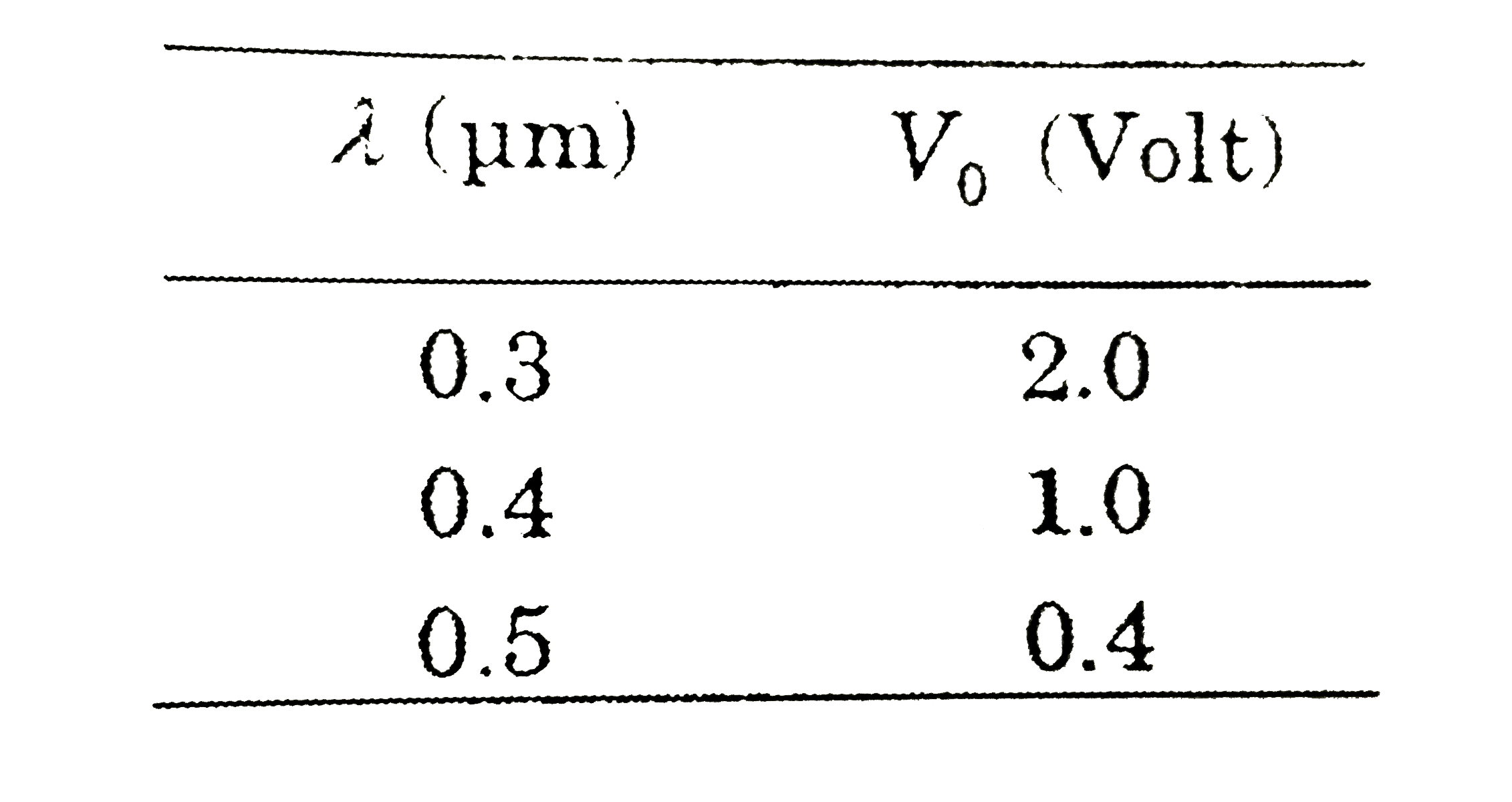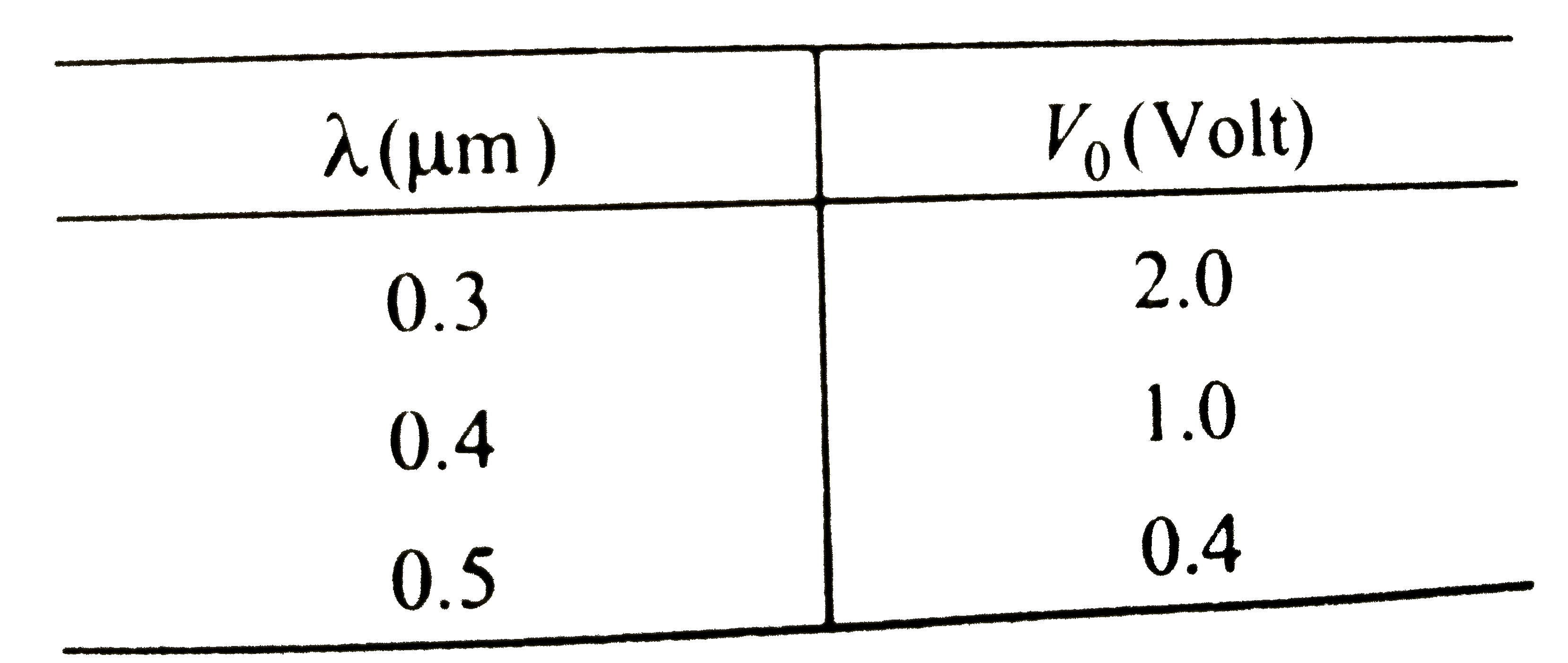In a historical experiment to determine Planck's constant, a metal surface was irradiated with light of different wavelengths. The emitted photoelectron energies were measured by applying a stopping potential. The relevant data for the wavelength (λ). ) of incident light and the corresponding stopping potential (V0) are given below :

Given that c=3×108ms−1ande=1.6×10−19C Planck's constant (in units of J s) found from such an experiment is
6.0×10−34
6.4×10−34
6.6×10−34
6.8×10−34
The correct Answer is:B
K.E.max=hcλ−ϕ=eV0
We can write the above equation for two different cases and then subtract from each other . We get the following equation :
hcλ1−hcλ2=e(V1−V2)
hc(10.3−10.4)110−6=1.6×10−19
hc(0.10.12)=1.6×10−25
h=1.6×10−25×1.23×108
=0.64×10−33=6.4×10−34Js.
We can calculate and verify the same using different values . We shall get the same result.
Topper's Solved these Questions
- BOOK - MODERN PUBLICATIONCHAPTER - DUAL NATURE OF RADIATION AND MATTER EXERCISE - COMPETITION FILE (OBJECTIVE TYPE QUESTIONS ( C - Multiple Choice Questions) )8videos
DUAL NATURE OF RADIATION AND MATTER
- BOOK - MODERN PUBLICATIONCHAPTER - DUAL NATURE OF RADIATION AND MATTER EXERCISE - COMPETITION FILE (OBJECTIVE TYPE QUESTIONS ( D - Multiple Choice Questions) )5videos
DUAL NATURE OF RADIATION AND MATTER
- BOOK - MODERN PUBLICATIONCHAPTER - DUAL NATURE OF RADIATION AND MATTER EXERCISE - COMPETITION FILE (OBJECTIVE TYPE QUESTIONS ( B - Multiple Choice Questions) (JEE (Main) & Other State Boards for Engineering entrance))18videos
DUAL NATURE OF RADIATION AND MATTER
- BOOK - MODERN PUBLICATIONCHAPTER - CURRENT ELECTRICITYEXERCISE - Chapter Practice Test15videos
CURRENT ELECTRICITY
- BOOK - MODERN PUBLICATIONCHAPTER - ELECTRIC CHARGES AND FIELDS EXERCISE - Chapter Practice Test15videos
ELECTRIC CHARGES AND FIELDS
Similar Questions
In a historical experiment to determine Planck's constant, a metal surface was irradiated with light of different wavelengths. The emitted photoelectron energies were measured by applying a stopping potential. The relevant data for the wavelength (λ). ) of incident light and the corresponding stopping potential (V0) are given below :

Given that c=3×108ms−1ande=1.6×10−19C Planck's constant (in units of J s) found from such an experiment isView SolutionWhen light of wavelength 400nm is incident on the cathode of photocell, the stopping potential recorded is 6V. If the wavelength of the incident light is to 600nm, calculate the new stopping potential. [Given h=6.6×10−34Js,c=3×108m/s,e=1.6×10−19C]
View Solution
Knowledge Check
- Question 1 - Select One
In a historical experiment to dtermine Planck's constant, a metal surface was irradiated with light of different wavelengths. The emitted photoelectron energies were measured by applying a stopping potential. The relevant data for wavelength (λ) of incident light and the corresponding stopping potential (V0) are given below

Given that c=3×108ms−1 and e=1.6×10−19C, Planck's constant (in units of J s) found from such an experiment is:A6.0×10−34B6.4×10−34C6.6×10−34D6.8×10−34. - Question 2 - Select One
When a metalic surface is illuminated with light of wavelength λ, the stopping potential is V. the same surface is illuminated by light of wavelength 2λ the stopping potential is V3 The thershold waelength for the surface is
A4λ3B4λC6λD8λ3 - Question 3 - Select One
When a certain metallic surface is irradiated with monochromatic light wavelength λ, the stopping potential for photoelectric current is 3V0. When the same surface is irradiated with light of wavelength 2λ, the stopping potential is V0 The threshold wavelength for the given surface is
A4λB6λC8λD4λ3
When a metal is illuminated by light of wavelength λ , the stopping potential is V∘ and for wavelength 2λ, it is 3V∘.Then the threshold wavelength is ?
View SolutionMetal surface emits photoelectrons when light of wavelength 400 nm is incident on it. Calculate the work function of the metal if stopping potential is 0.5 V.
View SolutionWhen light of wavelength λ is incident on photosensitive surface, the stopping potential is V. When light of wavelength 3λ is incident on same surface, the stopping potential is V6Thereshould wave length for the surface is
View SolutionLight of wavelength 3×10−7m is incident on a photosensitive surface . The stopping potential for emitted photoelectrons is 2.5 V . If the wavelength of incident light is reduced to 1.5×10−7 m , the stopping potential for emitted photoelectrons is
View SolutionWhen a photosensitive surface is illuminated with light of wavelength λ, the stopping potential is V0. But when light of wavelength 2λ is incident on the same surface, the stopping potential is V04. What is the threshold wavelength for the surface ?
View Solution

